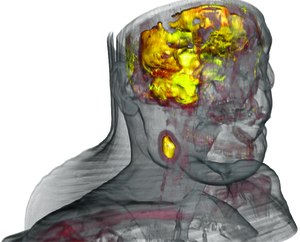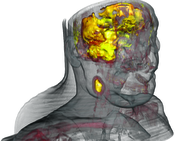Information
- Replaced by: haidacher-2008-vcbm
- Publication Type: Technical Report
- Workgroup(s)/Project(s):
- Date: April 2008
- Number: TR-186-2-08-04
- Keywords: Information-based classification, Information theory, Point-wise mutual information, Transfer functions, Multimodal visualization
Abstract
Transfer functions are an essential part of volume visualization. In multimodal visualization at least two values exist at every sample point. Additionally, other parameters, such as gradient magnitude, are often retrieved for each sample point. To find a good transfer function for this high number of parameters is challenging because of the complexity of this task. In this paper we present a general information-based approach for transfer function design in multimodal visualization which is independent of the used modality types. Based on information theory, the complex multi-dimensional transfer function space is fused to a well-known 2D transfer function with a single value and gradient magnitude as parameters. Additionally, a quantity is introduced which is used for achieving better separation of regions with complementary information. The benefit of the new method in contrast to other techniques is a transfer function space which is easy to understand and which provides a better separation of different tissues. The usability of the new approach is shown on examples of different modalities.Additional Files and Images
Weblinks
No further information available.BibTeX
@techreport{TR-186-2-08-04,
title = "Information-based Transfer Functions for Multimodal
Visualization",
author = "Martin Haidacher and Stefan Bruckner and Armin Kanitsar and
Eduard Gr\"{o}ller",
year = "2008",
abstract = "Transfer functions are an essential part of volume
visualization. In multimodal visualization at least two
values exist at every sample point. Additionally, other
parameters, such as gradient magnitude, are often retrieved
for each sample point. To find a good transfer function for
this high number of parameters is challenging because of the
complexity of this task. In this paper we present a general
information-based approach for transfer function design in
multimodal visualization which is independent of the used
modality types. Based on information theory, the complex
multi-dimensional transfer function space is fused to a
well-known 2D transfer function with a single value and
gradient magnitude as parameters. Additionally, a quantity
is introduced which is used for achieving better separation
of regions with complementary information. The benefit of
the new method in contrast to other techniques is a transfer
function space which is easy to understand and which
provides a better separation of different tissues. The
usability of the new approach is shown on examples of
different modalities.",
month = apr,
number = "TR-186-2-08-04",
address = "Favoritenstrasse 9-11/E193-02, A-1040 Vienna, Austria",
institution = "Institute of Computer Graphics and Algorithms, Vienna
University of Technology ",
note = "human contact: technical-report@cg.tuwien.ac.at",
keywords = "Information-based classification, Information theory,
Point-wise mutual information, Transfer functions,
Multimodal visualization",
URL = "https://www.cg.tuwien.ac.at/research/publications/2008/TR-186-2-08-04/",
}


 TechnicalReport
TechnicalReport
